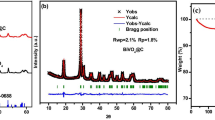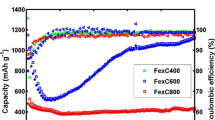Abstract
In this study, a Prussian Blue-bismuth (PB-Bi) microcube composite anode material was designed and synthesized by introducing Bi ions into Prussian blue (PB). Through the morphology, structure and electrochemical performance test at different heat treatment temperatures, it is found that Bi2O3/Fe2O3 composites inherit the microcube structure of PB at the optimum annealing temperature of 500 ℃. When used as anode material for lithium-ion batteries, the composite has excellent electrochemical performance, and its discharge specific capacity can still maintain 576.6 mAh g−1 after 100 cycles at the current density of 100 mA g−1. The results show that by introducing Bi ions into PB to form Bi2O3/Fe2O3 microcubic composite anode material, the active site of Li ion diffusion and migration is greatly improved, thus improving the excellent electrochemical performance of the anode material. All in all, the composites provide a new direction for the research of Bi-based lithium-ion battery anode materials.







Similar content being viewed by others
Data availability
The datasets generated during and/or analysed during the current study are available from the corresponding author on reasonable request.
References
Abu SM, Hannan M, Lipu M, Mannan M, Ker PJ, Hossain M, Mahlia T (2023) State of the art of lithium-ion battery material potentials: An analytical evaluations, issues and future research directions. J Clean Prod 394:136246. https://doi.org/10.1016/j.jclepro.2023.136246
Li XZ, Zhang M, Yuan SX, Lu CX (2020) Research progress of silicon/carbon anode materials for lithium-ion batteries: structure design and synthesis method. ChemElectroChem 7:4289–4302. https://doi.org/10.1002/celc.202001060
Chae S, Xu YB, Yi R, Lim H, Velickovic D, Li XL, Li QY, Wang CM, Zhang JG (2021) A micrometer-sized silicon/carbon composite anode synthesized by impregnation of petroleum pitch in nanoporous silicon. Adv Mater 33:2103095. https://doi.org/10.1002/adma.202103095
Shaker M, Ghazvini A, Shahalizade T, Gaho M, Mumtaz A, Javanmardi S, Riahifar R, Meng XM, Jin Z, Ge Q (2023) A review of nitrogen-doped carbon materials for lithium-ion battery anodes. New Carbon Mater 38:247–282. https://doi.org/10.1016/S1872-5805(23)60724-3
Huang ZD, Lu H, Qian K, Famg YW, Du QC, He YB, Masese T, Yang XS, Ma YW, Huang W (2018) Interfacial engineering enables Bi@C-TiOx microspheres as superpower and long life anode for lithium-ion batteries. Nano Energy 51:137–145. https://doi.org/10.1016/j.nanoen.2018.06.051
Zhang Y, Wang Q, Wang B, Mei Y, Lian P (2017) N-doped graphene/Bi nanocomposite with excellent electrochemical properties for lithium–ion batteries. Ionics 23:1407–1415. https://doi.org/10.1007/s11581-017-1975-3
Lan JL, Jin Y, Qin C, Yu Y, Yang X (2017) Bio-inspired rose-like Bi@nitrogen-enriched carbon towards high-performance lithium-ion batteries. Chem Select 2:7178–7184. https://doi.org/10.1002/slct.201701291
Liu Z, Jin SM, Cui KX, Zhao J, Xie SY, Li JZ, Chang XH (2020) Cavity containing core-shell Bi@C nanowires toward high performance lithium ion batteries. J Alloys Compd 842:155796. https://doi.org/10.1016/j.jallcom.2020.155796
Yang F, Yu F, Zhang Z, Zhang K, Lai Y, Li J (2016) Bismuth nanoparticles embedded in carbon spheres as anode materials for sodium/lithium-ion batteries. Chem Eur J 22:2333–2338. https://doi.org/10.1002/chem.201503272
Zhong YT, Li B, Li SM, Xu SY, Pan ZH, Huang QM, Xing LD, Wang CS, Li WS (2018) Bi nanoparticles anchored in N-doped porous carbon as anode of high energy density lithium ion battery. Nano-Micro Lett 10:56. https://doi.org/10.1007/s40820-018-0209-1
Zakaria MB, Hu M, Hayashi N, Tsujimoto Y, Ishihara S, Imura M, Suzuki N, Huang Y, Sakka Y, Ariga K, Wu K, Yamauchi Y (2014) Thermal conversion of hollow prussian blue nanoparticles into nanoporous iron oxides with crystallized hematite phase. Eur J Inorg Chem 7:1137–1141. https://doi.org/10.1002/ejic.201301307
Zhang L, Wu HB, Madhavi S, Hng HH, Lou XW (2012) Formation of Fe2O3 microboxes with hierarchical shell structures from metal-organic frameworks and their lithium storage properties. J Am Chem Soc 134:17388–17391. https://doi.org/10.1021/ja307475c
Ni J, Bi X, Jiang Y, Li L, Lu J (2017) Bismuth chalcogenide compounds Bi2X3 (X=O, S, Se): Applications in electrochemical energy storage. Nano Energy 34:356–366. https://doi.org/10.1016/j.nanoen.2017.02.041
Pattananuwat P, Khampuanbut A, Haromae H (2021) Novel electrode composites of mixed bismuth-iron oxide/graphene utilizing for photo assisted supercapacitors. Electrochim. Acta 370:137741. https://doi.org/10.1016/j.electacta.2021.137741
Santhosh S, Satish M, Yadav A, Madhavan A (2021) Thermal analysis of Fe2O3 - myristic acid nanocomposite for latent heat storage. Mater Today: Proc 43:3795–3798. https://doi.org/10.1016/j.matpr.2020.11.412
Al-Buriahi M, Hessien M, Alresheedi F, Al-Baradi AM, Alrowaili Z, Kebaili I, Olarinoye I (2022) ZnO-Bi2O3 nanopowders: Fabrication, structural, optical, and radiation shielding properties. Ceram Int 48:3464–3472. https://doi.org/10.1016/j.ceramint.2021.10.124
Hong W, Ge P, Jiang Y, Yang L, Tian Y, Zou G, Cao X, Hou H, Ji X (2019) Yolk-shell-structured bismuth@N-doped carbon anode for lithium-ion battery with high volumetric capacity. ACS Appl Mater Interfaces 11:10829–10840. https://doi.org/10.1021/acsami.8b20477
Xiong PX, Wu JX, Zhou MF, Xu YH (2020) Bismuth-antimony alloy nanoparticle@porous carbon nanosheet composite anode for high-performance potassium-ion batteries. ACS Nano 14:1018–1026. https://doi.org/10.1021/acsnano.9b08526
Zhang RL, Fang T, Ni LP, Zhu YP, Shen YH, Xie AJ, Lao L (2022) SnO2/Bi2O3/NF heterojunction with ordered macro/meso-pore structure as an advanced binder-free anode for lithium ion batteries. J Electroanal Chem 907:115894. https://doi.org/10.1016/j.jelechem.2021.115894
Yuan S, Zhao Y, Chen WB, Wu C, Wang XY, Zhang LN, Wang Q (2017) Self-assembled 3D hierarchical porous Bi2MoO6 microspheres toward high capacity and ultra-long-life anode material for Li-ion batteries. ACS Appl Mater Interfaces 9:21781–21790. https://doi.org/10.1021/acsami.7b04045
Liu H, Yang MM, Yi Z, Duan T, Yao WT (2021) Bi2O3/Bi nanocomposites confined by N-doped honeycomb-like porous carbon for high-rate and long-life lithium storage. Appl Mater Today 22:100885. https://doi.org/10.1016/j.apmt.2020.100885
Hong WW, Wang AN, Li L, Qiu TY, Li JY, Jiang YL, Zou GQ, Peng HJ, Hou HS, Ji XB (2021) Bi dots confined by functional carbon as high-performance anode for lithium ion batteries. Adv Funct Mater 31:2000756. https://doi.org/10.1002/adfm.202000756
Liang HC, Liu XY, Gao DL, Ni JF, Li Y (2017) Reduced graphene oxide decorated with Bi2O2.33 nanodots for superior lithium storage. Nano Res 10:3690–3697. https://doi.org/10.1007/s12274-017-1579-2
Liang HC, Ni JF, Li L (2017) Bio-inspired engineering of Bi2S3-PPy yolk-shell composite for highly durable lithium and sodium storage. Nano Energy 33:213–220. https://doi.org/10.1016/j.nanoen.2017.01.033
Tang CJ, Li NR, Sheng JZ, Zhou L, He L, Zhu JX, Li F, Liu YN, Mai LQ (2017) Facile synthesis of Bi2S3@SiO2 core-shell microwires as high-performance anode materials for lithium-ion batteries. J Electrochem Soc 164:6110–6115. https://doi.org/10.1149/2.0151701jes
Noh HN, Choi WC (2016) Preparation of a TiNb2O7 microsphere using formic acid and wrapping with reduced graphene oxide for anodes in lithium ion batteries. J Electrochem Soc 163:1042–1049. https://doi.org/10.1149/2.1181606jes
Chena XH, Tanga HL, Huang ZY, Zhou J, Ren XH, Huang K, Qi X, Zhong JX (2017) Flexible bismuth selenide /graphene composite paper for lithium-ion batteries. Ceram Int 43:1437–1442. https://doi.org/10.1016/j.ceramint.2016.10.110
Ye LQ, Wang LJ, Xie HQ, Su YR, Jin XL, Zhang C (2015) Two-dimensional layered BiOX (X = Cl, Br) compounds as anode materials for lithium-ion batteries. Energy Technol 3:1115–1120. https://doi.org/10.1002/ente.201500161
Wang YJ, Xie KF, Zhu YF, Tong K, Zhang MY, Wu FX (2023) Prussian blue microcubes-derived FeF3 cathodes for high-energy and ultra-stable lithium and lithium-ion batteries. J. Power Sources 577:233234. https://doi.org/10.1016/j.jpowsour.2023.233234
Tang Y, Hu JW, Tao HW, Li YJ, Li W, Li HM, Zhou M, Wang LK, Jiang K (2021) Rational design of Prussian blue analogues as conversion anodes for lithium-ion batteries with high capacity and long cycle life. J Alloys Compd 891:161867. https://doi.org/10.1016/j.jallcom.2021.161867
Hou TY, Fan AR, Sun XH, Zhang X, Xu ZK, Cai S, Zheng CM (2021) Improving cycling stability of Bi-encapsulated carbon fibers for lithium/sodium-ion batteries by Fe2O3 pinning. Chin Chem Lett 32:2459–2462. https://doi.org/10.1016/j.cclet.2021.01.049
Acknowledgements
The authors would like to acknowledge North China University of Science and Technology.
Author information
Authors and Affiliations
Contributions
Shaowei Yao: made substantial contributions to the conception or design of the work; drafted the work or revised it critically for important intellectual content. Chonghua Shi: the acquisition, analysis; or the creation of new software used in the work. Xinyu Liu: agree to be accountable for all aspects of the work in ensuring that questions related to the accuracy or integrity of any part of the work are appropriately investigated and resolved. Jiajin Nie: interpretation of data. Xuegang Ma: approved the version to be published.
Corresponding authors
Ethics declarations
Competing interests
All authors certify that they have no affiliations with or involvement in any organization or entity with any financial interest or non-financial interest in the subject matter or materials discussed in this manuscript. No funds, grants, or other support was received.
Additional information
Publisher's Note
Springer Nature remains neutral with regard to jurisdictional claims in published maps and institutional affiliations.
Rights and permissions
Springer Nature or its licensor (e.g. a society or other partner) holds exclusive rights to this article under a publishing agreement with the author(s) or other rightsholder(s); author self-archiving of the accepted manuscript version of this article is solely governed by the terms of such publishing agreement and applicable law.
About this article
Cite this article
Yao, S., Shi, C., Liu, X. et al. Bi2O3/Fe2O3 composite of microcube structure derived from Prussian blue as anode materials for lithium-ion batteries. Ionics 29, 4629–4638 (2023). https://doi.org/10.1007/s11581-023-05189-3
Received:
Revised:
Accepted:
Published:
Issue Date:
DOI: https://doi.org/10.1007/s11581-023-05189-3




